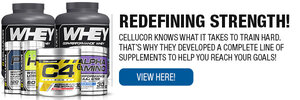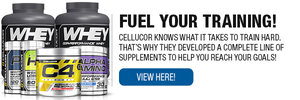01dragonslayer
Ripped
- Jacked Cash
- 472,445
It’s good to be strong.
We don’t need to use this article to go over the endless benefits of having more general strength. We all know what they are.
What this article will highlight is something that the fitness world could do well to put to question. Let’s start things off with a comparison.
In the professional modeling world, it’s well known that an often told optimum “standard” for “ideal beauty” is to have a waist measurement that is approximately 70% of the hip measurement.
In the bodybuilding world, having an arm circumference that equals your calf and neck circumference is ideal for symmetry and balanced development.
These two examples are aesthetic based and serve no other purpose than visual appeal to whoever made those rules in the first place.
The strength training world makes several standards as well. Goals such as having a deadlift of 2x bodyweight and a squat of 1.5-1.75x bodyweight to be deemed “strong” compared to other lifters. Most lifters desire to place themselves in this elite category of strength compared to the average person.
It’s great to set goals concerning your performance and I’m a believer that most people shouldn’t set a ceiling on how strong they want to be. But there’s a bit more to the story here.
Related: 1 Rep Max Bench Press Calculator

I say this because most people are so terribly deconditioned that to even get to average levels of strength – the strength that allows you to stand tall, manipulate your body in various positions, and exist without chronic pain – takes a prolonged training effort.
When we’re talking about conditioned individuals who’ve been in the gym, however, the conversation changes.
It’s one thing to be able to squat or deadlift 2 or 3 times your weight, but it’s another to answer why.
In my book, there are women who have ratios that aren’t exactly 0.7 who are just as, if not more, attractive to look at. Likewise, having these strength standards met isn’t the end all be all when it comes to determining your strength levels and whether you can deem yourself a strong person.
If you’re not a competitor where training for strength is directly related to how well you perform in a competition, it’s useful to question your entire motive for chasing extreme strength results.

And believe me, I get weight training is a hobby for every one of us, just as much as it’s a pursuit of health, fitness and wellness. But at the end of the day, I’m sure many honest people will agree that one key factor is responsible for a good 50% of next level strength goals.
Both sets of numbers are very strong. Usually, the pursuit of breaking one’s own PR in the gym is fuelled by a competitive spirit against oneself or one’s training partners. That is the real reason goals like this even come about in the world of recreational lifting.
It’s a great feeling to set a new personal record. It’s a great feeling to be stronger than most people and it may even inspire you. But at the end of the day, how strong is strong enough for a typical adult male or female to lead a healthy life and do whatever he or she wants in and out of the gym?
I don’t have the answer.

With that said, I think an average lifter should be able to make a goal of the following with good form:
Related: Workout Routines for Beginners
What’s more, is the above goals have one more thing to offer: They’re sustainable.
The shelf life of a guy who learns to deadlift 700 pounds will maybe be a few years, while likely at greater risk for injury having a higher PR. The contrast is clear when comparing this to the shelf life of someone who may have a high PR, but learns to make the most of deadlifting 400 pounds using various techniques, methods, and rep schemes. The shelf life of that guy can be 40 years.

Reading this shouldn’t make an already strong recreational lifter become complacent with his current abilities and ditch his strength training workouts altogether in favor of rep work.
It should open his eyes to a new vantage point from which to view his programming. If your undying goals are to bench 500lbs and squat 600lbs are driven by nothing more than ego, it may be a good idea to rethink your strategy. Especially if you don’t have aspirations of competing anytime soon.
Furthermore, this doesn’t mean you should never test your max efforts or go through a strength training phase again. You should do it, but you should probably do it a bit less since improving your already good strength won’t be as urgent of a priority compared to those who are beginners or just plain weak.
Make gradual improvements and retest your maxes a couple times a year. If you’re at 1.85x bodyweight and not 2x bodyweight for your deadlifts, don’t beat yourself up. You’re still strong and you’ll be fine.
We don’t need to use this article to go over the endless benefits of having more general strength. We all know what they are.
What this article will highlight is something that the fitness world could do well to put to question. Let’s start things off with a comparison.
In the professional modeling world, it’s well known that an often told optimum “standard” for “ideal beauty” is to have a waist measurement that is approximately 70% of the hip measurement.
In the bodybuilding world, having an arm circumference that equals your calf and neck circumference is ideal for symmetry and balanced development.
These two examples are aesthetic based and serve no other purpose than visual appeal to whoever made those rules in the first place.
The strength training world makes several standards as well. Goals such as having a deadlift of 2x bodyweight and a squat of 1.5-1.75x bodyweight to be deemed “strong” compared to other lifters. Most lifters desire to place themselves in this elite category of strength compared to the average person.
It’s great to set goals concerning your performance and I’m a believer that most people shouldn’t set a ceiling on how strong they want to be. But there’s a bit more to the story here.
Related: 1 Rep Max Bench Press Calculator

Strong Enough?
The reason I say most lifters shouldn’t set a ceiling on their strength is not because I believe this across the board.I say this because most people are so terribly deconditioned that to even get to average levels of strength – the strength that allows you to stand tall, manipulate your body in various positions, and exist without chronic pain – takes a prolonged training effort.
When we’re talking about conditioned individuals who’ve been in the gym, however, the conversation changes.
It’s one thing to be able to squat or deadlift 2 or 3 times your weight, but it’s another to answer why.
In my book, there are women who have ratios that aren’t exactly 0.7 who are just as, if not more, attractive to look at. Likewise, having these strength standards met isn’t the end all be all when it comes to determining your strength levels and whether you can deem yourself a strong person.
If you’re not a competitor where training for strength is directly related to how well you perform in a competition, it’s useful to question your entire motive for chasing extreme strength results.

And believe me, I get weight training is a hobby for every one of us, just as much as it’s a pursuit of health, fitness and wellness. But at the end of the day, I’m sure many honest people will agree that one key factor is responsible for a good 50% of next level strength goals.
Ego
I don’t care what anyone says against this; being able to squat or deadlift triple bodyweight creates no added real world benefit compard to someone who can only squat or deadlift double bodyweight. Until I’m proven otherwise, I’ll stand by this statement.Both sets of numbers are very strong. Usually, the pursuit of breaking one’s own PR in the gym is fuelled by a competitive spirit against oneself or one’s training partners. That is the real reason goals like this even come about in the world of recreational lifting.
It’s a great feeling to set a new personal record. It’s a great feeling to be stronger than most people and it may even inspire you. But at the end of the day, how strong is strong enough for a typical adult male or female to lead a healthy life and do whatever he or she wants in and out of the gym?
I don’t have the answer.
Lee Boyce’s Real World Strength Standards
I like staying closer to the body weight equivalent to really gauge ideal and practical strength levels. Creating an absolute single effort force is good to do and gauge. However, it doesn’t translate too much other than that particular lift and has less application compared to being able to combine strength, time under tension, and other sustaining efforts.
With that said, I think an average lifter should be able to make a goal of the following with good form:
- Bodyweight Equivalent Full Range Back Squat: 8-10 Reps
- Bodyweight Strict Pull Up or Chin Up: 10-12 Reps
- 0.75x Bodyweight Overhead Pess: 3 Reps
- 1.25x Bodyweight Deadlift: 10 Reps
Related: Workout Routines for Beginners
What’s more, is the above goals have one more thing to offer: They’re sustainable.
The shelf life of a guy who learns to deadlift 700 pounds will maybe be a few years, while likely at greater risk for injury having a higher PR. The contrast is clear when comparing this to the shelf life of someone who may have a high PR, but learns to make the most of deadlifting 400 pounds using various techniques, methods, and rep schemes. The shelf life of that guy can be 40 years.

What This All Means
Actually, let me tell you what it doesn’t mean.Reading this shouldn’t make an already strong recreational lifter become complacent with his current abilities and ditch his strength training workouts altogether in favor of rep work.
It should open his eyes to a new vantage point from which to view his programming. If your undying goals are to bench 500lbs and squat 600lbs are driven by nothing more than ego, it may be a good idea to rethink your strategy. Especially if you don’t have aspirations of competing anytime soon.
Furthermore, this doesn’t mean you should never test your max efforts or go through a strength training phase again. You should do it, but you should probably do it a bit less since improving your already good strength won’t be as urgent of a priority compared to those who are beginners or just plain weak.
Make gradual improvements and retest your maxes a couple times a year. If you’re at 1.85x bodyweight and not 2x bodyweight for your deadlifts, don’t beat yourself up. You’re still strong and you’ll be fine.

